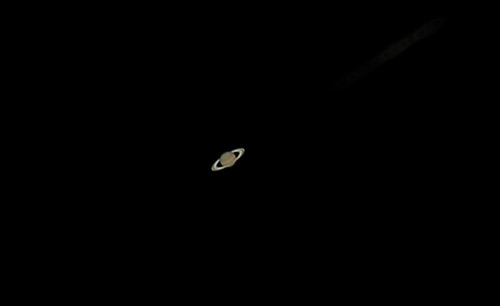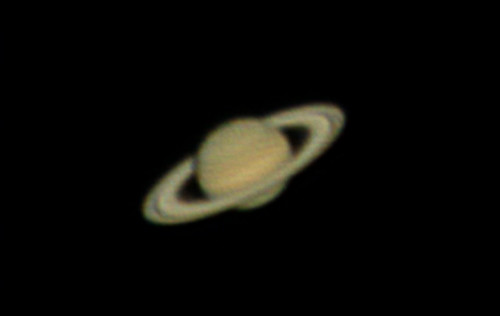 |
| Using BackyardEOS to capture images through the Dob' |
The images below were taken using my Skywatcher 8" Dobsonian telescope, with the body of my Canon 600D mounted onto it using a T-ring. As this telescope is stationary, requiring manual movement to find your target, Saturn passes through the view of the camera in around 20 seconds. In order to capture the images below, I used a piece of software called BackyardEOS (which Cheryl bought me for my birthday :-)), which has a feature that records short videos of your target passing by due to the rotation of the earth.
 |
| Saturn - using Canon 600D body mounted with a T-ring onto an 8'' Dobsonian |
Each video was around 200 - 300 frames, and each of the frames are then stacked using Registax 6 into a finished image. Stacking basically takes the 'best bits' of each frame, and puts them together. As the light from Saturn takes so long to reach us, it is often distorted.
To increase magnification, a 2x barlow lens was used between the camera body and the telescope, which magnifies Saturn by 2x. This can increase the image size of the end result, but by magnifying it twice, you are halving the time it takes for Saturn to pass your view - meaning shorter videos and less frames to stack together. I am very happy with both results and especially proud that I even managed to capture the Cassini Division - the black line that runs through the middle of the rings. This 'division' is caused by the gravitational pull from one of Saturn's moons (Mimas) causing the debris in the ring to veer off course, causing an emptier section of the rings.
 |
| Saturn - Taken with Canon 600D with 2x barlow adapter on a 8" Dobsonian |
Each of the images have their good and bad points. I think the first image has better colouring, and is a sharper image as it's not as zoomed in, but the second image has a little more details, but is slightly distorted through less frames and more zoom. A lot of the skill and patience in astrophotography is required in the processing stages. Once you have captured your photos and data, it is using that information the best you can in order to find the best results. It can take hours to stack many images, which may not always achieve desired results. I'd like to one day give more information and tutorials about processing, but at the moment I'm pretty new to it and don't really know what I'm doing most of the time!

No comments:
Post a Comment